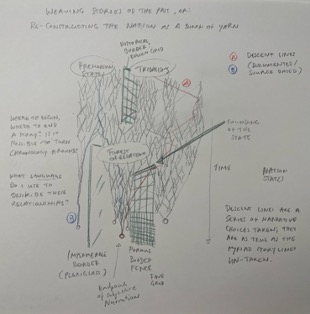Weaving Stories
In Austronesian-speaking Oceania, genealogy represents the chief connector between past and present, political authority and imagined communities. Damon Salesa describes Oceanian genealogies as locating historical memory in an “ancestral space-time,” subverting the borders of state, chronology, and colonial bureaucracy. This contribution explores how kinship, descent and tribalism can be represented in three dimensions, overcoming the limitations of linear time and avoiding subjection to the analytical vocabulary of colonial administration. How can the diachronical structures that become visible – blood line, adoption, posthumous appropriation etc. – inspire new modalities of historical writing, about Oceania and other societies?

Genealogy is personal, subjective and situational. This project is based on my study of an influential family in Chuuk, Federated Micronesia. In Chuuk’s matrilinear tradition, different qualities of descent lines connect to father’s and mother’s clans, and they branch out into the traditional kinship networks of American, Japanese, German and Spanish colonizers. Descent lines thus merge with colonial power lines that shape the structure of modern genealogy. Today, diplomacy, business and cultural exchange unfold along these transimperial genealogies.
How can these structures of kinship be represented spatially, to help understand the “ancestral space-time” of an ongoing present in Oceania? Mapping ancestral space time in its global dimension is also an experimental inversion of epistemic hierarchies: kinship can no longer be reduced to a family tree with blood lines as trunk and branches, but it becomes a complex construct of values, identities and associations. Engaging with Micronesian cultures of memory at a methodological level means to abandon rigid separations between humanistic disciplines and meeting the living memory where it stands: at the intersection of history, literature and artistic expression.
